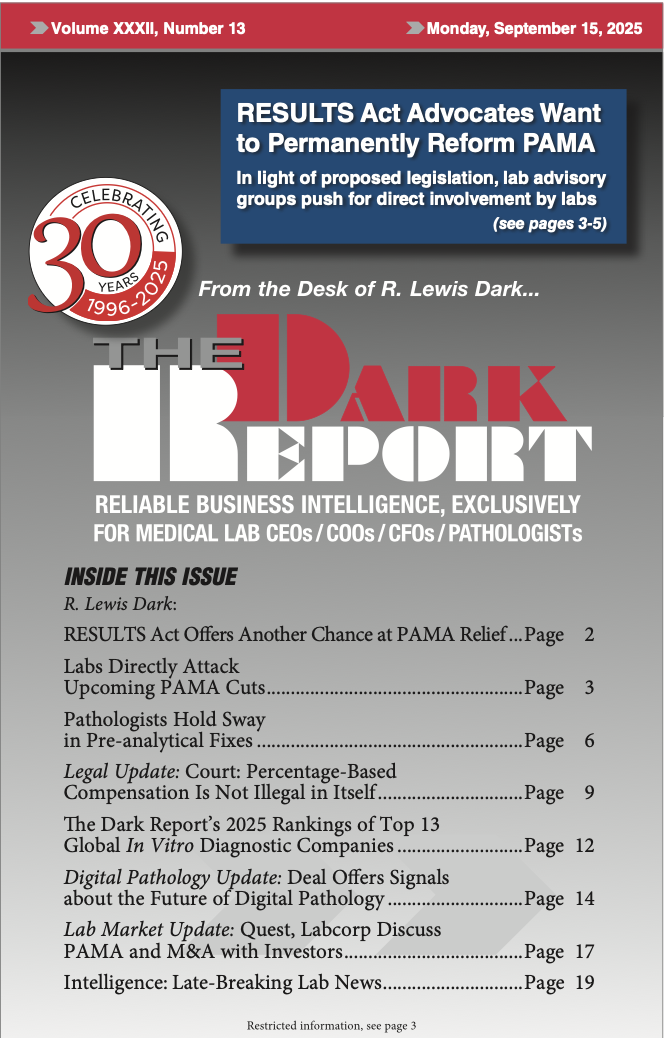Laboratory Management
Laboratory management in today’s clinical lab industry is changing rapidly and facing entirely new challenges. One problem is the lack of upcoming younger lab managers, as the retirements of baby boomer pathologists, medical technologists and lab scientists are in the near future. These individuals make up the largest proportion of supervisors, managers, and lab administrators working in labs today.
As they retire, every clinical lab and pathology group needs to have the next generation of leaders ready to step up and assume responsibilities. But, across the lab industry, there are limited opportunities for every lab’s brightest up-and-comers to get the regular management development opportunities that are common among Fortune 500 companies. The Dark Intelligence Group has called for the establishment of a mentoring program to help overcome this problem.
At the same time, downward pressure on reimbursements and mounting competition have created an environment that requires much more effort for a medical lab to grow and thrive.
Legislation, including the Health Information Technology for Economic and Clinical Health Act (HITECH) of 2009 and the Patient Protection and Affordable Care Act (PPACA) of 2010, have placed significant demands on medical laboratories and healthcare providers to improve internal efficiency even while offering more services for less money. This pressure to “do more with less” is further compounded by the need to deliver increasingly personalized client service to retain and win clients.
With the era of fee-for-service medicine coming to a close, every clinical laboratory and anatomic pathology organization needs a strategy for getting paid, as new reimbursement models that support patient-centric care will make up a larger portion of lab revenues.
The challenge for every clinical laboratory manager is to understand how to evolve from a business model that is accession-centric or volume-centric to one that is patient-centric.
Many clinical laboratories today are developing data repositories to logically link all transactional and other information about a patient. These repositories allow physicians to see all relevant information, identify trends, and provide better care as a result, enabling labs to provide greater value to their customers, patients and payers, thus creating more value and becoming more patient-centric.
Several Labs Planning A Public Stock Offering
By Robert Michel | From the Volume V No. 9 – July 6, 1998 Issue
CEO SUMMARY: During the past six years, no general clinical laboratory company has undergone an initial public stock offering (IPO). That will certainly change during the next 24 months. There are several private lab companies which want to go public. But this business strategy can only s…
THE DARK REPORT’S Annual Public Laboratory Rankings
By Robert Michel | From the Volume V No. 9 – July 6, 1998 Issue
Beckman Coulter’s Strategy Reflects Consolidation Trends
By Robert Michel | From the Volume V No. 9 – July 6, 1998 Issue
CEO SUMMARY: Rapid changes to the clinical laboratory industry had equally profound impact upon the major diagnostic companies. At Beckman Coulter, Inc., market forces triggered a decade of acquisitions and internal consolidation.The company looks very different today than it did ten year…
Express Scripts, InformInvestor.com, UroCor, Bio-Reference Laboratories
By Robert Michel | From the Volume V No. 9 – July 6, 1998 Issue
PRESCRIPTION DRUG SPENDING HITS A RECORD INCREASE OF 17.4% IN 1999 Just-released data from Express Scripts, Inc. indicates that spending on prescription drugs increased by a record 17.4% during 1999. This compares to a 9.6% spending increase for drugs in 1998. As most lab e…
1-For-10 Reverse Stock Split Boosts LabCorp’s Share Price
By Robert Michel | From the Volume V No. 9 – July 6, 1998 Issue
MAY PROVED TO BE an auspicious time for Laboratory Corporation of America to restructure its equity base. In the process, it’s positioning itself to be a tougher competitor in the lab testing marketplace. Ever since the company was first created by the merger of Roche Biom…
ProxyMed, MedePass, Cigna, Aetna
By Robert Michel | From the Volume V No. 9 – July 6, 1998 Issue
FORMER SBCL PRESIDENT HAS QUICK TOUR AS CEO OF PROXYMED, INC. IT WAS A SHORT TOUR OF DUTY as Chief Executive Officer at ProxyMed, Inc. for John B. Okkerse, Jr., Ph.D. On May 19, after only six months as ProxyMed’s CEO, Dr. Okkerse stepped down as part of a cost-cutting mo…
BRLI Ready To Leverage Physician Relationship
By Robert Michel | From the Volume V No. 9 – July 6, 1998 Issue
CEO SUMMARY: As healthcare E-commerce rapidly approaches, clinical laboratories will find they have a built-in competitive advantage—their existing business relationship and communication links to physician offices. Bio-Reference Laboratories, Inc. is moving rapidly to capitalize on thi…
New CEO Takes Charge At Pathology Partners
By Robert Michel | From the Volume V No. 9 – July 6, 1998 Issue
CEO SUMMARY: Pathology Partners, Inc. got a new President and CEO this month. The company is organized to build and operate independent regional histology and cytology laboratories in support of anatomic pathologists. Its business model is different than competing pathology companies and …
Columbia/HCA, AmeriPath, Epitope, STC Technologies, Quest Diagnostics
By Robert Michel | From the Volume V No. 9 – July 6, 1998 Issue
COLUMBIA/HCA GETS NEW NAME; ACQUIRES FOUR LONDON HOSPITALS NOW THAT IT HAS A SETTLEMENT with the federal government on civil claims of Medicare fraud, expect a rapid cascade of changes at Columbia/HCA Healthcare Corporation, the nation’s largest for-profit hospital company…
Luminex Raises $83 Mil In Public Stock Offering
By Robert Michel | From the Volume V No. 9 – July 6, 1998 Issue
CEO SUMMARY: During the past year, Luminex Corporation moved swiftly to push its LabMAP™ multiplex testing technology into the bioassay marketplace. It found high interest among companies in the pharmaceutical, diagnostics, and bioresearch industries. Luminex executives say that a numbe…
CURRENT ISSUE

Volume XXXII, No. 13 – September 15, 2025
The Dark Report examines a new bill that would reform PAMA and avoid reimbursement rate cuts scheduled for January 2026. Clinical laboratory leaders are urged to make their voices heard in Congress. Also, an expert describes how labs can fix pre-analytical errors and avoid disaster.
See the full table of contentsHow Much Laboratory Business Intelligence Have You Missed?
Lab leaders rely on THE DARK REPORT for actionable intelligence on important developments in the business of laboratory testing. Maximize the money you make-and the money you keep! Best of all, it is released every three weeks!
Sign up for TDR Insider
Join the Dark Intelligence Group FREE and get TDR Insider FREE!
Never miss a single update on the issues that matter to you and your business.
Topics
- Anatomic Pathology
- Clinical Chemistry
- Clinical Laboratory
- Clinical Laboratory Trends
- Digital Pathology
- Genetic Testing
- In Vitro Diagnostics
- IVD/Lab Informatics
- Lab Intelligence
- Lab Marketplace
- Lab Risk & Compliance
- Laboratory Automation
- Laboratory Billing
- Laboratory Compliance
- Laboratory Equipment
- Laboratory Information Systems
- Laboratory Management
- Lean Six Sigma
- Managed Care Contracts
- Molecular Diagnostics
- Pathology Trends
- People
- Uncategorized

